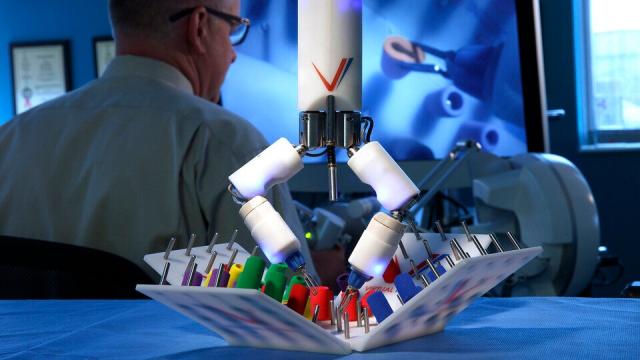A surgery-performing robot developed by the University of Nebraska-Lincoln and medical technology company Virtual Incision is ready to be tested aboard the International Space Station with a $US100,000 ($138,820) grant awarded to the university from NASA.
NASA has big plans for the future of spaceflight, including an interest in performing surgery. That’s why the agency issued a grant of $US100,000 ($138,820) to the University of Nebraska-Lincoln. The money will be used to prepare a surgery-performing robot for testing aboard the ISS 2024. The robot is called MIRA, which stands for “miniaturized in-vivo robotic assistant,” and can be operated remotely by a surgeon as a non-invasive way to perform medical procedures in space. MIRA is a joint venture between the University of Nebraska-Lincoln and Virtual Incision, a medical technology startup that operates on the university’s Nebraska Innovation Campus.
“The Virtual Incision MIRA platform was designed to deliver the power of a mainframe robotic-assisted surgery device in a miniaturized size, with the goal of making [robotic-assisted surgery] accessible in any operating room on the planet,” said John Murphy, CEO of Virtual Incision, in a company press release. “Working with NASA aboard the space station will test how MIRA can make surgery accessible in even the most faraway places.”
While the ride to the ISS is a huge step, MIRA won’t be slicing into astronauts aboard just yet. The robot will instead operate inside a locker that’s about the size of a microwave, cutting tissue analogues and moving rings along a wire. Over the next year, professor of engineering and Virtual Incision co-founder John Farritor — who helped developed MIRA — and graduate student Rachael Wagner will write the robot’s software, and conduct tests to make sure that the robot survives the launch to the ISS. Previous tests include retired astronaut Clayton Anderson controlling MIRA from 900 miles (1448 kilometers) across Earth, and the successful removal of colon tissue in procedures conducted by surgeons.
While launching MIRA to the ISS is interesting enough, this seems like the first sign of NASA’s plans for long term space travel — however far off those plans may be. With the announcement of Lunar Gateway, an orbiting lunar outpost from NASA and its international and private partners, prompt medical procedures in space will be a paramount objective in the event of some life-threatening accident.
More: Congress Sneaks NASA Authorization Bill into CHIPS, Approves Moon-to-Mars Program
